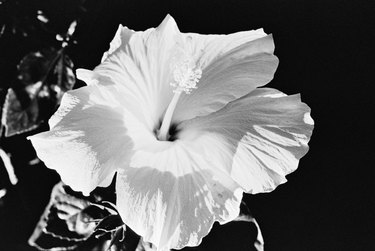
Hibiscus are tropical plants that produce lovely colorful blooms almost year round. These blooms last for one day before wilting. Keeping hibiscus healthy requires proper watering, application of fertilizers and insect control. Spider mites and aphids are two pests that are often red in color and damage hibiscus.
Types
Video of the Day
Spider mites are common hibiscus pests, as well as many other flowers, trees and shrubs. These mites vary in color but can be red, green, brown or black. Injuring hibiscus leaves and flowers through feeding, spider mites are usually located on the undersides of plant leaves. Severe infestations can cause serious damage to hibiscus and may eventually kill the plant. Aphids are another tiny pest that is often brightly colored in red or pink or may be dull black or brown. These insects also feed underneath of plant leaves, usually on tender new growth. Both aphids and spider mites are so small, they are hard to see without a magnifying glass.
Video of the Day
Effects/Diagnosis
Examine your hibiscus for signs of insect infestations, using a magnifying glass. Look at the tips of shoots and buds for aphids. Spider mites often place webbing on infested plants, which is produced by special glands. Place a white sheet of paper underneath hibiscus leaves and shake. Spider mites will fall to the white paper if they are present on your plant. Some signs of aphid feeding include distorted new growth and reduced vigor. When aphids feed, they remove large amounts of sap from infested plants. This sap is excreted in the form of honeydew, which is a sticky sweet clear liquid that lands on hibiscus leaves and flowers. Black sooty mold fungi adheres to honeydew and causes hibiscus to turn black with fungus. Ants and bees are drawn to this sweet coating of fungus, as well. While sooty mold is unattractive, it does not usually kill plants. Spider mite feeding causes plant leaves to appear flecked with yellow specks, turn bronze and appear burnt or scorched. Hibiscus infested with spider mites often lose their leaves prematurely.
Non-Chemical Control
Natural predatory insects use aphids and spider mites for food, keeping them under control. Aphis lions and lady beetles are two insects that feed on aphids and spider mites. Rinsing your hibiscus with a brisk stream of water can knock damaging insects such as spider mites and aphids onto the ground. Repeat this process two or three times each week for continued control. Water rinses also help remove silky webbing, which can cause the plant to look dirty or dusty.
Chemical Control
Aphids and spider mites may be controlled by applying soft pesticides known as horticultural oils to the foliage of infested hibiscus. Horticultural oils coat the insect with oil and clog their breathing holes which kills them. Insecticidal soaps may also control aphids and spider mites. Be sure to start at the bottom of your hibiscus and aim up to get insecticides to the undersides of plant leaves where these pests congregate. Repeat soap sprays once each week until insects are under control.
- ACES: Hibiscus: A Plant That Blooms All Year
- National Gardening Association: Aphids On Hibiscus
- Colorado State University; Managing Houseplant Pests; W.S Cranshaw; November 2006
- Colorado State University; Spider Mites; W.S Cranshaw; D.C Sclar; November 2006
- University of Illinois; Aphids The Bug Review;